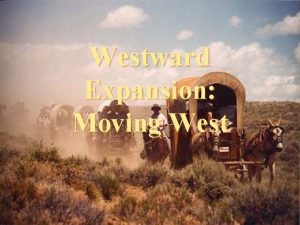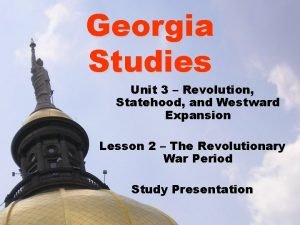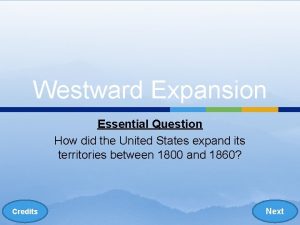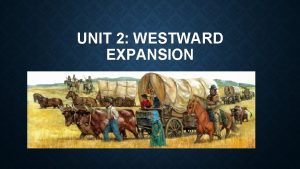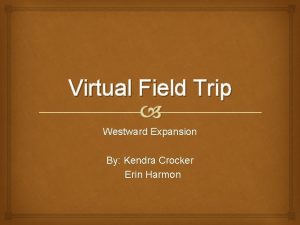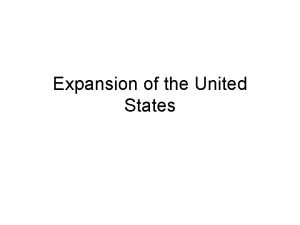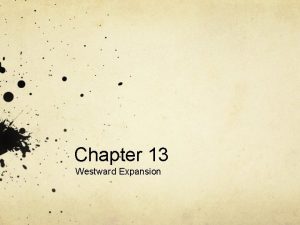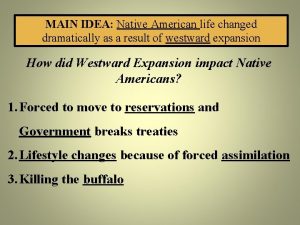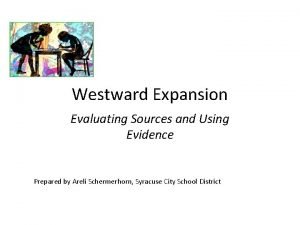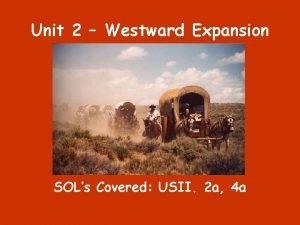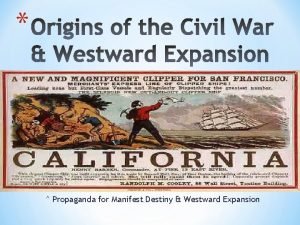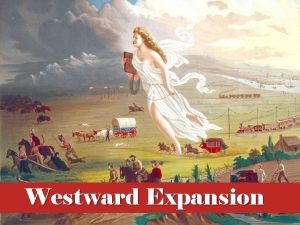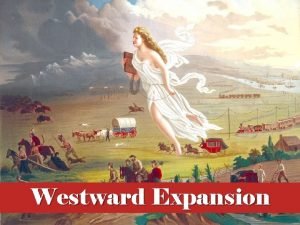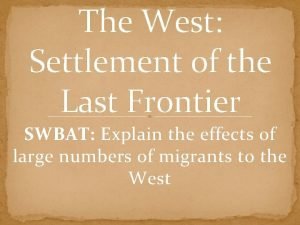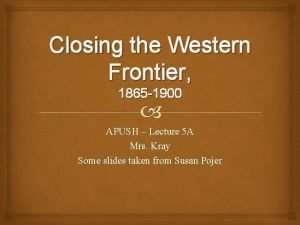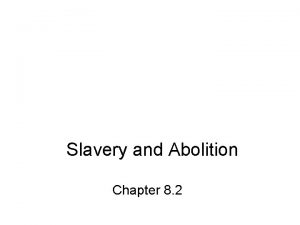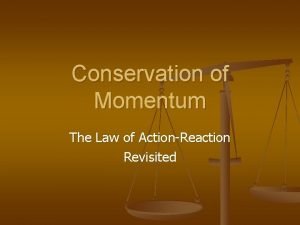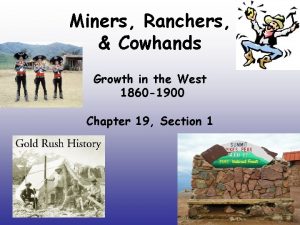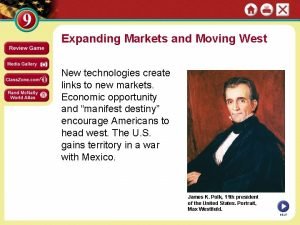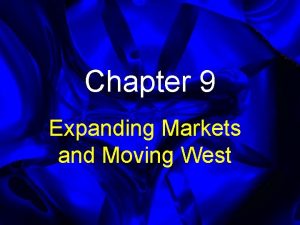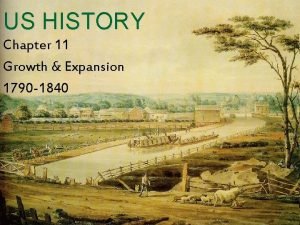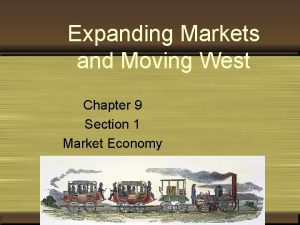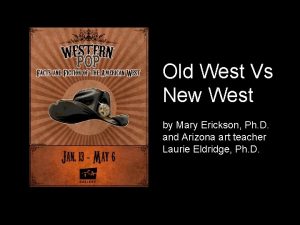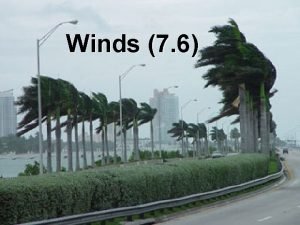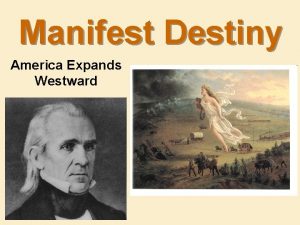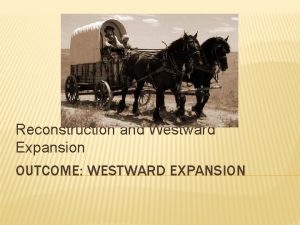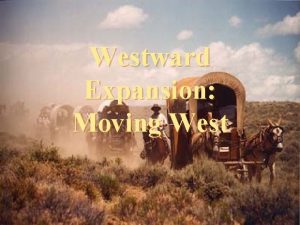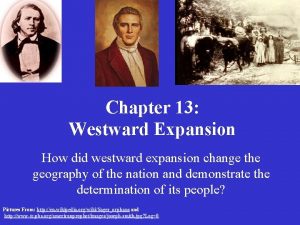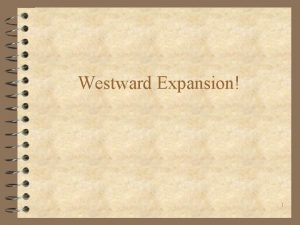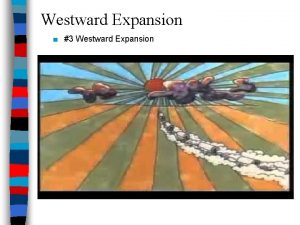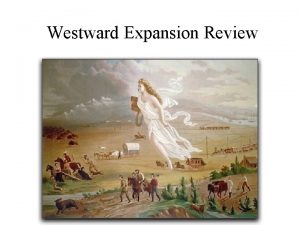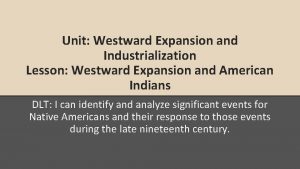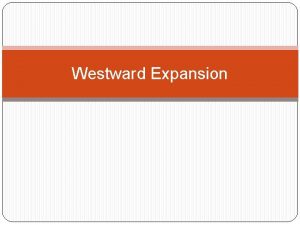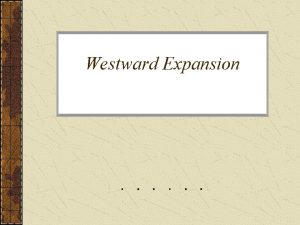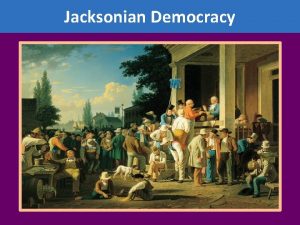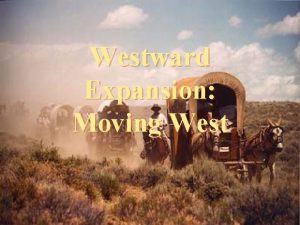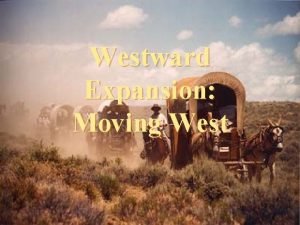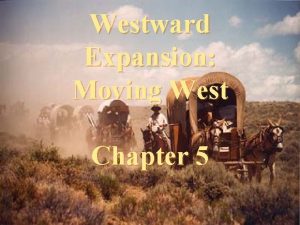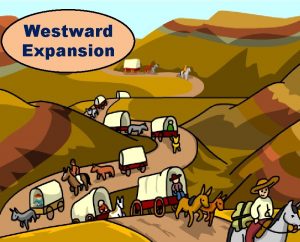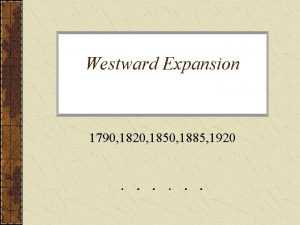Westward Expansion Moving West Turners Frontier Thesis n





















































- Slides: 53

Westward Expansion: Moving West

Turner’s Frontier Thesis… n American social development has been continually beginning over again on the frontier. This perennial rebirth, this fluidity of American life, this expansion westward with its new opportunities, its continuous touch with the simplicity of primitive society, furnish the forces dominating American character. The true point of view in the history of this nation is not the Atlantic coast, it is the Great West. - Frederick Jackson Turner, 1893

Reasons why people moved west after the Civil War n In the East, farmland was expensive n n Poor people could not buy their own land Sharecropping was how many poor whites and exslaves had to farm In the west was “wide open” areas –especially the Great Plains where “only” some Indians lived Gold and silver was discovered – drawing people who wanted to get rich quick

Turner’s Frontier Thesis n n Oklahoma Territory (old Indian Territory) opened for settlement in 1889 Last great land rush 1890: U. S. Census Bureau declared that the frontier had been settled “Significance of the Frontier in American History” (1893) n Expansion had promoted independence and individualism n Free land a “safety valve” for discontent n Were we doomed to follow the social conflict represented in Europe?

Settlement of the Last Frontier n People began to migrate to “the Great American Desert” after the Civil War n The Great Plains, the Rocky Mountains, and the Western Plateau n Little rainfall, open grasslands, buffalo n By 1900, buffalo were wiped out and homesteads were fenced in n 3 groups of pioneers: miners, cattlemen/cowboys, and farmers

More Reasons for Moving West n Mountain Men and Trappers had been moving west since Colonial times n n Still chance to make money – animals were still abundant Millions of buffalo lived on the Great Plains – easy to kill and hides worth money back east Sense of adventure and freedom Chance to start a new life – outlaws or in debt

Manifest Destiny n n n Americans, stirred by their hunger for land the ideology of “Manifest Destiny, ” flocked to the new frontiers. Manifest Destiny means an obvious fate of the Untied States to grow and become powerful regardless of who or what was in their way – Indians, buffalo, Mexicans Conflicts between American settlers and Indian nations in the Southeast and the old Northwest resulted in the relocation of many Indians to reservations.

Westward Expansion n American migration into Texas led to an armed revolt against Mexican rule and a famous battle at the Alamo, in which a band of Texans fought to the last man against a vastly superior force. The Texans’ eventual victory over Mexican forces subsequently brought Texas into the Union.

Manifest Destiny: Mexican American War n n n The United States fought Mexico in the Mexican-American War in the 1840 s This was due in large part the desire of Mexican held lands The American victory in the war led to the addition of an enormous territory that included the present-day states of California, Nevada, Utah, Arizona, and parts of Colorado, and New Mexico.

Removal of the Native Americans n Diverse population n n New Mexico and Arizona: Pueblo farmed in permanent settlements Navajo and Apache of the SW were nomadic hunter-gatherers who had to adapt Pacific Northwest: Chinook developed communities based on hunting and fishing 2/3 of tribes were nomadic, living on the Great Plains and hunting buffalo (Sioux, Blackfoot, Cheyenne, Crow, Comanche)


Impact on the American Indians n n n During this period of westward expansion, the settlers repeated wanted Indian land – leading to fights and wars The American Indians were repeatedly defeated in violent conflicts with settlers and soldiers and removed from their lands. Many atrocities

Reservations n n n 1830 s: Jackson moved Natives westward into “Indian Territory” U. S. Government negotiated with tribes in 1851 and moved them to reservations Many other tribes forced to reservations – land supposed to be set aside for Indians Generally poor land, no hunting, not good for crops Indians often starved and died of disease

Trail of Tears n n n One of most famous is the Trail of Tears Cherokees and other tribes were removed from their homes in winter and rorced to march far away from their homes to Oklahoma Many died – old people, women, children Came through Missouri Many of us have Cherokee blood from those abandoned here

The Homestead Act of 1862 • The Homestead Act gave public lands (lands owned by the national government) to American citizens

Homestead Act n n n Law signed by Lincoln in 1862 For a small fee a person could obtain 160 acres for free But not really free – were some rules n n n At least 21 years old or head of a family American citizen or immigrant filing for citizenship Build house a minimum size (12 feet by 14 feet) Live in house 6 months out of year Farm land 5 yrs in a row before ownership set 372, 000 new farms - 600, 000 land claims – 80 million acres

The Farming Frontier n Homestead Act of 1862 n Offered 160 acres of land free to families who settled it for 5 years n Many families ended up paying for the best land that was owned by railroad companies and speculators


In the photos above, the blue square represents one acre.

Effects: • The Homestead Act helped poor families who could not afford land in the eastern states. • It gave unemployed workers a chance to find work on land of their own. Daniel Freeman Standing, Holding Gun, with Hatchet Tucked in Belt, The "first homesteader" to settle in Beatrice, Nebraska, 1863.

• Thousands of African-Americans moved west in 1879 in an effort to find a better life. • This was known as the “Exodus of 1879”, and the participants were called “Exodusters”.

The Farming Frontier: Problems and Solutions n n n n n “Sodbusters” Extremes of hot and cold Grasshopper plagues Isolation Water was scarce Falling prices High cost of new machinery “Dry-farming” and deep-plowing techniques Dams and irrigation saved many

Indians fought back… n As Indians lost more and more land, they fought back – losing almost all their battles – and they did lose the war n n n Sandy Creek Massacre (1864) - Colorado Battle of Little Big Horn (1876) – Dakotas, Wyoming and Montana Battle of Wounded Knee (1890) – South Dakota

Indian Wars n n 1864: Colorado militia massacred Cheyenne women, children, and men at Sand Creek, Colorado Sioux War of 1865 -1867: Army detachment wiped out by the Sioux Treaties provided for reservations after these battles, but miners refused to stay off land 1870 s: second Sioux War led by Sitting Bull and Crazy Horse n Eventually defeated by the Army, but Custer’s command was destroyed at Little Big Horn in 1876

The Black Hills n n A treaty was signed between the U. S. government and Lakota leaders. The treaty gave the Black Hills reservation to the Lakota people forever.

Gold miners illegally rushed onto the reservation when gold was discovered.

The Battle of Little Bighorn n George Custer was to defeat the Lakota and force them onto a new reservation.

Crazy Horse helped lead the Lakota to victory at the Battle of Little Bighorn. George Custer and his men were all killed. This battle was known as “Custer’s Last Stand. ”

Why was the battle important? n n It was the biggest victory Native Americans ever won over United States forces. It led to the end of freedom for Native Americans of the Great Plains.

What then… n n The United States sent more soldiers to the Black Hills and forced the Lakota to a new reservation. The Black Hills were open to gold miners and settlers from the United States.

Ghost Dance Movement n n n Religious movement Misunderstood Government tried to suppress Sioux medicine man Sitting Bull was killed December 1890: Over 200 Native American men, women, and children were gunned down at Wounded Knee in the Dakotas

Battlefield at Wounded Knee n n When the Lakota surrendered, someone fired a shot. About 300 Lakota were killed.

The Battle at Wounded Knee n n n The last major conflict between the United States and Native Americans occurred at Wounded Knee, South Dakota. Lakota families decided to leave their reservation. After being surrounded by U. S. soldiers, the Lakota decided to surrender.

Assimilationists n A Century of Dishonor (1881) by Helen Hunt Jackson n Created sympathy for Native Americans n Many proposed education and conversion to Christianity

Dawes Severalty Act (1887) n n n n The US government stopped negotiating treaties with the Native Americans as separate nations. This allowed the US government not to recognize the sovereign nations of the Native Americans and take on the more aggressive policy of assimilation. Families would receive 160 acres or less U. S. citizenship was granted to those who stayed on land for 25 years and became “civilized” Best land sold to white settlers by government, speculators, and even Native Americans Policy failed Disease and poverty reduced population to 200, 000 The failure of the Bureau of Indian Affairs to manage this trust fund will bring about the lawsuits from the Native American tribes in the 1990 s.

Indian Reorganization of 1934 n n n This signals a major reversal of previous federal Indian policies. Instead of forcing Native Americans to give up all of their customs and traditions to be farmers or live in cities, the IRA gave them back their rights to live as separate cultures. Tribes were allowed to form their own governments among their reservations to increase tribal holdings and encouraged tribal customs. This will end the push for assimilation. It will also remove the federal responsibility to the Native American Tribes under previous policies.

The Mining Frontier n n n California Gold Rush in 1849 was only the start Gold and silver strikes in Colorado, Nevada, Idaho, Montana, Arizona, and South Dakota Comstock Lode ($340 million in gold and silver by 1890) responsible for Nevada entering the Union in 1864

Gold and Silver Strikes The CA Gold Rush began in 1849, attracting thousands of gold hunters known as forty-niners.

Major "Strikes" in the California Gold Rush In 1852 the take for the year was $80 million ($1. 9 billion in 2005 dollars). Sutter's Mill/Coloma Jan. 24, 1848 James Marshall kicked off the California gold rush when he spotted some pea-sized bits of gold in a mill raceway. The news brought thousands of prospectors to the area, but neither Marshall nor his employer John Sutter prospered from the find.

Gold and silver mines were discovered throughout the West. Thousands of miners from the U. S. , Europe, Mexico, and China flocked to the West. White and Chinese miners hoping to strike it rich during the California Gold Rush at Auburn Ravine in 1852.

Mining Towns n n Towns grew quickly and became famous for saloons, dance-hall girls, and vigilante justice Many became ghost towns after the mining boom 1/3 of western miners were Chinese immigrants Miner’s Tax: $20/month for all foreign-born miners Virginia City, Nevada

Effects of Mining Impact on the economics and politics of the U. S. n Environmental problems n Native Americans lost their land n

Cowboys n n Buffalo were in the way of railroads and settlers so had to be removed Also, hides worth money back east 25 million buffalo killed (1840 -1889) Replaced with cattle – and rise of the cowboy

Reasons for rise of cattle industry ·After the Civil War, growing cities in the East increased their demand for beef. Some cattle had gotten lose in Texas and during the war had been forgotten – so large herds developed and were available for the taking Railroads had reached Kansas, where cattle could be shipped east Texas ranchers began to drive herds of longhorns hundreds of miles north to the railroads, where they were shipped east.

The Cattle Frontier n n n Traditions and techniques borrowed from Mexicans Railroad construction into Kansas opened up eastern markets for Texas cattle Cowboys, many of whom were blacks and Mexicans, earned about $1 a day Long cattle drives ended in 1880 s after overgrazing destroyed the grass and a blizzard and drought killed off about 90% of the cattle Barbed wire revolutionized ranching (Joseph Glidden)

· Cow towns developed near the railroads, offering cowhands hotels, saloons, and restaurants. Abilene, Kansas (late 1800’s)

The spread of farming, as well as harsh weather, destroyed the cattle boom by 1887. Hundreds of miles of barbed wire were strung across the state in the 1880 s, forever changing the character of the frontier and bringing a measure of management to the cattle industry.

The Transcontinental Railroad · Railroad companies raced to lay tracks to the mines in order to supply the miners.

Promontory Point, Utah . Central Pacific Railroad x Omaha, Nebraska . Union Pacific Railroad J j Sacramento, California · In 1863, two companies, the Union Pacific and the Central Pacific, began building the first transcontinental railroad.

Immigrant Workers Central Pacific approximately 90% of their workforce were Chinese immigrants · Labor was scarce due to the Union Pacific - hard, dangerous hired many work and low Irish pay. immigrants · Therefore, immigrant labor was used.

· The workers endured scorching deserts, blinding snowstorms, and blasted through mountains. Chinese railroad workers perform their duties in the snow.

Transcontinental Railroad n n The Transcontinental Railroad Completed in May 10, 1869 at Promontory Point Utah. The railroads cut travel time west from six months to six days!

On May 10, 1869, a golden spike was hammered into a track joining the two tracks in Promontory Point, UT.
 Westward expansion thesis statement
Westward expansion thesis statement Unit 3 rev. statehood and westward expansion
Unit 3 rev. statehood and westward expansion Westward expansion clip art
Westward expansion clip art Who made it
Who made it Westward expansion vocabulary
Westward expansion vocabulary Gained voter support by helping immigrants find jobs.
Gained voter support by helping immigrants find jobs. Us territorial acquisitions map
Us territorial acquisitions map Unit 2 westward expansion vocabulary
Unit 2 westward expansion vocabulary A trip westward question and answer
A trip westward question and answer Westward expansion map
Westward expansion map Westward expansion wagon
Westward expansion wagon Gilded age acrostic poem
Gilded age acrostic poem Chapter 13 westward expansion
Chapter 13 westward expansion Assimilation westward expansion
Assimilation westward expansion Horace greeley letter to r.l sanderson
Horace greeley letter to r.l sanderson Westward expansion
Westward expansion Westward expansion lewis and clark
Westward expansion lewis and clark Unit 2 westward expansion vocabulary
Unit 2 westward expansion vocabulary California gold rush advertisement
California gold rush advertisement Great plains westward expansion
Great plains westward expansion American expansion westward/manifest destiny
American expansion westward/manifest destiny Westward expansion essential questions
Westward expansion essential questions Westward expansion discussion questions
Westward expansion discussion questions Westward expansion vocabulary
Westward expansion vocabulary Frontier detectors for frontier physics
Frontier detectors for frontier physics The west: settlement of the last frontier
The west: settlement of the last frontier The closing of the frontier apush
The closing of the frontier apush Turner frontier thesis summary
Turner frontier thesis summary Mri position
Mri position The abolitionists
The abolitionists Xyy
Xyy Samate turners
Samate turners Syndrome edward
Syndrome edward Unwarping turners
Unwarping turners Unwarping turners
Unwarping turners Turners syndrome
Turners syndrome Action reaction and momentum conservation
Action reaction and momentum conservation Chapter 9 expanding markets and moving west
Chapter 9 expanding markets and moving west Moving west
Moving west Expanding markets and moving west
Expanding markets and moving west Chapter 9 expanding markets and moving west
Chapter 9 expanding markets and moving west Chapter 11 growth and expansion
Chapter 11 growth and expansion Lesson 2 moving west
Lesson 2 moving west Chapter 9 expanding markets and moving west
Chapter 9 expanding markets and moving west West noord zuid oost
West noord zuid oost East is east and west is west
East is east and west is west Wind is horizontal movement of air
Wind is horizontal movement of air Old west vs new west
Old west vs new west Name of the wind series
Name of the wind series Emanuel leutze westward the course of empire
Emanuel leutze westward the course of empire World oldest age
World oldest age Closed thesis statement definition
Closed thesis statement definition Forbidden frontier cedar point
Forbidden frontier cedar point Production possibility frontier model
Production possibility frontier model
